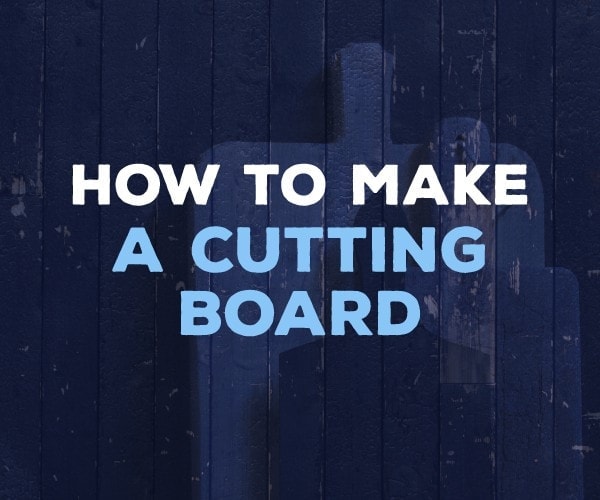If you’re looking to hone your woodworking chops, making a cutting board is a great place to polish your skills while developing new ones in the process.
Today, we’ll cover everything you need to know to create a gorgeous hardwood cutting board with some basic woodworking tools. If you need a recommendation for high quality walnut cutting boards that are reasonably priced, check out these walnut cutting boards made by Artisan Born: Black Walnut Wood Cutting Board, Solid Walnut Live Edge Cutting Board, and Live Edge Walnut Slab Cutting Board.
Table of contents
What You’ll Need
When it comes to how to make a cutting board, the project can be as easy or as involved as you want it to be. We’re going to apply some slightly advanced techniques in this tutorial, but feel free to make changes to the steps below based on how comfortable you feel with the project.
Here’s everything you’ll need:
- Piece of MDF or plywood
- Hardwood stock (maple, walnut, and mahogany work great, but feel free to experiment)
- Table saw (a circular or miter saw will work fine, too)
- Jigsaw
- Router
- Planer (optional)
- Palm sander
- 3-4 bar clamps
- Wood glue
- Small paintbrush
- Double sided tape
- Cutting board oil
- Carpenter’s pencil
- Work gloves
- Safety goggles
Step I: Making the Template
The first step is going to be making a template for the cutting board. I like to use MDF or plywood for my templates. Acrylic or polycarbonate are also good options if you want to create an especially durable template.
This part is entirely up to you. Trace the shape you like onto the template, and cut it to size.
Step II: Cutting the Hardwood
Next, you’ll need to cut your hardwood strips. There’s no need to be exact with your measurements unless you want to be. I think that a cutting board with a random pattern looks best, but if you want a bit more continuity, feel free to cut all your strips to specific widths.
The one thing you’ll want to be mindful of is the thickness of each strip, as this will determine the thickness of your cutting board. Go with somewhere in the vicinity of 1 ½” for the thickness.
Be sure to wear proper safety gear before you begin cutting, and always make sure you’re working safely.
Step III: Gluing the Strips
Next, you’ll glue up the strips for the cutting board. If you’re making a particularly large cutting board, you can glue the strips together in sections, and then join the sections together afterward.
Apply a generous amount of glue to both sides of each strip, and brush the glue evenly across each strip.
Now you can join each strip of wood together and clamp them in place. Allow the glue to dry for 24 hours.
Step IV: Planing the Cutting Board
Now, we’ll plane the top and bottom of the cutting board. This will get rid of the glue that’s seeped out during step III, and it’ll provide us with a nice, even surface to work with.
If you don’t have a planer, you can tackle this step using a router. This video does a perfect job of explaining how you can plane your cutting board using a router and a simple jig.
If you’re lucky enough to have a planer, just feed the wood through the planer, then flip it over and put it back through the planer again.
Step V: Rough in Your Shape
We’re now ready to rough in the shape of the cutting board.
Place your template on top of your cutting board and trace the shape using a carpenter’s pencil.
Then, rough in the shape for your cutting board using a jigsaw.
Step VI: Finalizing the Shape
We’re almost there! With the shape of the cutting board roughed in, it’s now time to head to the router to finish up the shaping.
Apply double stick tape throughout your template and attach it to your cutting board. Using a flush trim router bit, route the cutting board to shape.
If you’d like to apply a decorative flourish to your cutting board, switch over to the roundover bit of your choice (⅜” and ½” work well for a cutting board) and route each edge of the cutting board.
Step VII: Finishing Touches
At this point, all that’s left is sanding and finishing the cutting board.
Using a palm sander, sand both sides of the cutting board. Start with 80 and finish with 200 grit, as this will provide a silky smooth surface for your cutting board.
Once you’re finished, clean the board of any residual sawdust and finish the cutting board.
Any type of oil-based finish will look great on your new cutting board. Mineral oil, linseed oil, and tung oil all work well. There are even oils on the market specifically for cutting boards.
Dump a healthy amount of oil onto the surface of the cutting board, and rub it in using a clean shop rag. Repeat the process on the opposite side of the cutting board. Give the board 24 hours to suck in the oil, and then repeat the process once more.
Final Word
Learning how to make a cutting board can be a fun and rewarding woodworking project, and a great way to hone your skills. This project involves a bunch of different power tools, so it’s especially important that you’re working safely. Take your time, always use proper safety equipment, and make sure to have fun!

